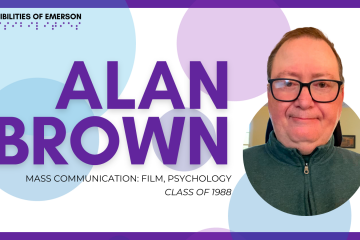Patricia Peyton ’84 is an Emerson alumna embodying many of the college’s core characteristics. Whether you’re talking about Pat’s involvement as a student leader, a Resident Assistant, and an active Sorority member or her current position on the college’s Board of Trustees, it’s clear that she has a strong passion for giving back to her alma mater.
Pat is currently the Managing Director of Sphere International, a global company focused on improving business leadership and sales through personalized consulting. Pat earned her Bachelor of Science in Organizational Behavior in 1984.
Pat’s new book Physical Intelligence was published this week with the honor of receiving the the aware for Business Book of the Year in the personal development category.

On Bleeding Purple:
What or who were your biggest influences at Emerson College?:
Patricia: “My biggest influences at Emerson were my three years in student government and as an RA, as well as other extra-curricular activities, especially Kappa Gamma Chi. Many of the friends I made through student government, as an RA, and through Kappa remain my closest friends today. That is not to say that class work wasn’t important – I had wonderful professors and a unique opportunity to study in Belgium where, along with another student, I worked to help establish what is now the Kasteel Well program – an experience that transformed my vision of what my future could be.
I have worked in my field since before I graduated (through internships), a field I love. I met my husband through this work. As a result, I view Emerson as a defining factor in the trajectory of my professional and personal life – and, along with the love and support of my wonderful family, one of the most significant influences in my life. That is why I “bleed purple,” as the saying goes, and consider giving back to Emerson a privilege and a responsibility.”
On Consulting Work:
Describe the work you do at Sphere International:
“At Sphere, we provide leadership, sales, and communications consulting, training, and coaching for companies across all industries and around the world, (e.g., Google, Facebook, J.P. Morgan, Citibank, Tiffany, Johnson & Johnson, etc.). In other words, we enable individuals, teams and organizations to enhance their performance by helping them become better salespeople, negotiators, presenters, influencers, communicators, coaches, and leaders.
For more than 20 years we have partnered with clients to design and deliver customized solutions, based on each client’s unique needs and our proven methodologies.
Our solutions include process consulting, training (on dialogue skills and strategy), and/or executive or team coaching, as well as ongoing reinforcement. Right now, given the COVID-19 crisis we have been very busy transferring classroom training to virtual delivery and developing webinars, videos and tips with guidance for our clients’ on how to lead teams in the midst of crisis and sell in a virtual environment.”
Physical Intelligence:
You recently came out with a book titled Physical Intelligence. Tell us a little about it and what inspired you to write it:
“Right now, there are hundreds of chemicals (hormones and neurotransmitters) racing through each of our bodies in our bloodstream and nervous system. Those chemicals dictate how we think, feel, speak and behave. Most of us operate largely at the mercy of those chemicals, experiencing thoughts, reactions and emotions, without realizing that we can strategically influence them. Physical Intelligence is the ability to detect and actively manage the balance of certain key chemicals through how we breathe, move, think, and interact, so that we can achieve more, stress less, and live and work more happily.
While some people have started to cobble together techniques to help them cope, such as meditation and yoga, both of which we fully support, in our experience, most people are not fully aware that there is a broader body of knowledge and hundreds of techniques, which we call Physical Intelligence. Many of the Physical Intelligence techniques we teach have been used for decades in the worlds of sports and the arts; (I learned some of them while at Emerson!).
I co-authored Physical Intelligence (published by Simon and Schuster) with Claire Dale, the founder of Companies in Motion, a company based in the UK where I’m a Director. I have a background in dance (15 years of training at an amateur level) and voice (years of singing, the voice and articulation training I received at Emerson, and years of work as a voice over artist) and my co-author is a former dancer and choreographer who had her own contemporary dance company in England.”
Self-Awareness:
We all bring ourselves to work. And we all have the opportunity to reflect on areas to grow as professional womxn. What are some of the internal biases you’ve had to recognize and address so that they don’t impact on your work?:
“As a small child growing up in a very segregated white, Christian urban neighborhood, I somehow took to heart what I had been taught about “all men being created equal” and “in God’s image” and recall from the age of six having a strong, negative visceral reaction to race and religious biases. While those are biases I saw around me and rejected, as a white American, even one who grew up without much materially, I certainly have experienced white privilege – something I didn’t always understand, but certainly know now.
In terms of biases I have had, earlier in my career, I learned the importance of adapting to different communication and behavior styles. I’m not an extreme personality style – in Myers Briggs terms, I’m an ENFP, but in each instance, my results ride the center line, (very close to ISTJ), to the point where the person analyzing my results asked me if I “get along with absolutely everyone” I meet. While I do tend to get along with most people, I am a type A person, a “driver” and also an “expressive,” and my brain moves very quickly. Before I understood the concept of different communication and behavior styles, I had to stop myself from rash judging others.
Years ago, I also, embarrassingly, discovered that I was biased in terms of how I defined intelligence – focusing purely on cognitive intelligence without considering that there are multiple intelligences, for example, recognizing that someone with high kinesthetic intelligence could build a life that was as successful or more successful than someone with high cognitive intelligence. (See Howard Gardner’s Frames of Mind: The Theory of Multiple Intelligences*.) Working closely with personal fitness trainers helped me recognize that bias and revise my thinking. I now completely believe that variety is the spice of life and diversity of all kinds across the teams strengthens it.”
*linguistic (‘word smart’), logical-mathematical (‘number/reasoning smart’), spatial (‘picture smart’), musical (‘music smart’), interpersonal (‘people smart’), intrapersonal (‘self smart’), naturalist (‘nature smart’) and bodily-kinesthetic (‘body smart’)
Womxn and the Workplace:
What are some common issues you’ve noticed that womxn have to face in their careers and what are the issues that have impacted you based on your individual background?:
“I am very fortunate in that I spent many years early in my career working for a company founded and owned by a woman before establishing my own consulting practice. However, because I have spent a considerable amount of time with clients in male-dominated industries, such as financial services and technology, I am familiar with challenges unique to women through first-hand experience and observation of client cultures. For example, as much as it saddens and frustrates me to acknowledge this, women generally still have to work harder and be more successful in order to be promoted to the same level as their male peers and to receive equal pay. Misogyny is not as prevalent (or openly prevalent) as it used to be, but it still exists. Women who are not “buddies” with male decision makers, in certain environments may still get passed over for promotion, and executive/board level roles remain overwhelmingly male.
Women are also significantly more susceptible to sexual harassment in the workplace than men. That’s not unique to the entertainment industry – it pervades all industries – and I have had to deal with that on occasion, including truly frightening circumstances.
Also, as we have seen recently in the current political environment, women continue to be judged differently than men in terms of how we communicate. For example, we walk a very fine line between speaking with confidence and being perceived as strident, between standing our ground and being labelled “pushy,” between showing our emotions and being viewed as weak or hysterical. This is an old story – one I had hoped we would have left behind us by now but it seems we shall have to persist in what clearly requires a long-term effort. It is very important that we have endurance – remaining focused, confident, resolute, and energized. Money and data talk. One or even a few successful women may be considered an anomaly. Multiple women building successful businesses, leading established businesses to greater success, driving innovation, can’t be passed off as exceptions.
We need to move the cause forward by enlightening people about the positive business impact of promoting deserving women to leadership roles, leveraging success stories – business achievements associated with women in leadership roles – something Emersonians are uniquely qualified to do.”



